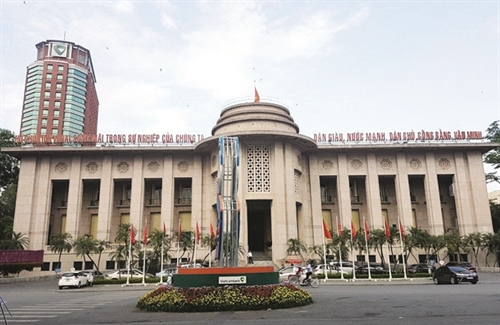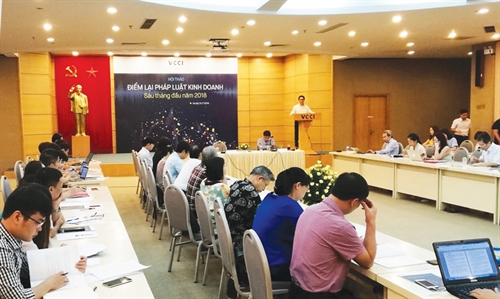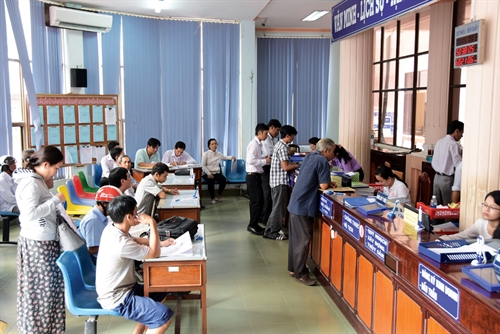 |
The Strategy for development of the banking sector up to 2030 has been recently approved by the Prime Minister, setting forth major objectives for operations of the credit institution system as well as state management responsibilities of the State Bank. Below is an interview granted by Deputy Governor of the State Bank Nguyen Kim Anh to Thoi bao Ngan hang (Banking Times) about the Strategy.
What are the major objectives of the Strategy?
After thoroughly evaluating the development of the banking sector over the last two decades and identifying opportunities and challenges at home and abroad in the next 10 years, taking into consideration the sector’s development viewpoints, the Strategy sets overall objectives for the development of the banking sector up to 2025 and 2030.
Accordingly, the State Bank of Vietnam will be modernized after a rational organizational model and operate in a synchronous, efficient and effective manner in conformity with the rules of the socialist-oriented market economy, and have full legal position and accountability.
Three fundamental functions of the central bank’s state management work have been clearly spelled out. Specifically, the monetary policy must aim at the priority target of controlling inflation, contributing to macro-economic stabilization and boosting sustainable growth. Banking inspection and supervision activities must ensure the safety and soundness of the credit institution system, with the State Bank playing the key role in ensuring financial stability. As for payment activities, the State Bank will supervise payment systems and act as the payment and settlement center for all payment systems and financial and monetary transaction systems of the economy.
The system of credit institutions will be developed in the direction of promoting the leading role of domestic credit institutions; operating in a transparent, competitive, safe and sustainably effective manner; being diversified in ownership, scope and type; and applying advanced banking technologies and governance standards in line with international practices.
By 2025, Vietnam’s credit institution system will reach the development level of the top four ASEAN nations, operate dynamically and creatively so as to adapt to the process of liberalization and globalization and meet the ever-increasing demand for financial and banking services in the country. By 2030, all people and businesses will have full and convenient access to quality financial and banking services, thus realizing financial inclusion and contributing to sustainable development.
The Strategy sets forth seven specific objectives.
Firstly, to gradually increase the independence, proactivity and accountability of the State Bank for the fulfillment of the objectives of the monetary policy, controlling inflation at an appropriate level suitable to socio-economic development orientations in each period, helping stabilize the macro-economy and boosting sustainable economic growth.
The foreign currency credit-to-total credit ratio will be step by step reduced. The foreign currency deposit-to-total payment instrument ratio will drop to below 7.5 percent by 2020 and 5 percent by 2030. The extension of foreign-currency loans will be stopped so as to basically tackle the situation of dollarization by 2030 at the latest.
Secondly, to strengthen the State Bank’s institutional capacity as well as improve its banking inspection and supervision activities. The scope of banking inspection and supervision will be expanded to cover also financial groups with parent companies being credit institutions. By the end of 2025, banking inspection and supervision activities will comply with most Basel principles for effective banking supervision.
Thirdly, to boost the development of cashless payment methods and optimize ATM and POS networks. By the end of 2020 and 2025, cash payment will account for less than 10 percent and below 8 percent of the total payment instruments, respectively.
Fourthly, to increase the number of businesses and people having access to financial and banking services provided by credit institutions. To develop appropriate services for inhabitants in rural, deep-lying, remote, and socio-economic difficulty-hit areas, who have no or little access to traditional banking services.
Fifthly, to develop the credit institution system in conformity with socio-economic conditions. During the 2018-20 period, efforts will be concentrated on restructuring the system according to the approved scheme. In the next period from 2021 to 2025, to focus on increasing their competitiveness, promoting transparency and ensuring compliance with international standards and practices.
Sixthly, to increase the effectiveness of credit capital allocated for socio-economic development. To boost the development of “green credit” and “green banks” so as to contribute to gearing the economy toward green growth, low-carbon emission and climate change resilience. To raise the proportion of bank loans invested in renewable energy, clean energy and low-carbon industries. At the same time, to include sustainable development, climate change and green growth issues in programs and projects eligible for loans.
Finally, to step by step heighten Vietnam’s position at international monetary and banking forums and organizations, serving the development of the banking sector in the context of international integration.
 |
| The headquarters of the State Bank of Vietnam__Photo: VNA |
What are major solutions and the roadmap for implementation of the Strategy?
In order to realize the set targets, the banking sector should synchronously implement 11 groups of tasks and solutions.
We should further improve the legal framework governing monetary and banking activities in conformity with the rules of the market economy and international practices and integration requirements. To improve the capacity, heighten the position, and promote the autonomy and accountability of the State Bank. To develop, manage and supervise important payment systems of the economy.
To increase the effectiveness of the banking inspection and supervision system in line with international practices and standards. To develop modern banking products and services, creating the basis for facilitating access to banking services. To develop credit institutions capable of competing in the domestic market and step by step improve their international competitiveness.
To improve other models of financial institutions operating in the banking sector. To promote the application and development of science and technology and develop human resources for the banking sector. To increase international cooperation and boost international integration in the banking sector and, at the same time, promote public information work of the State Bank.
The above solutions will be implemented in three stages, 2018-20,
2021-25, and 2026-30, according to different projects, component strategies and schemes. The banking sector will draw up an action program assigning specific tasks and setting deadlines for completion of each objective and solution set out in the Strategy.
What experiences has the State Bank drawn from its operation over the past 10 years for the formulation of the Strategy?
From its practical activities over the past 10 years, the State Bank has drawn useful lessons for the formulation of the Strategy. First, it is necessary to stick to the long-term objective of stabilizing the macro-economy together with persistently pursuing the monetary policy of controlling inflation. Second, state agencies must perform their administration tasks in a proactive and flexible manner, attaching importance to the stability, soundness and sustainability of banking operations, avoiding “hot” development and extensive growth without paying attention to growth quality.
We should respect market rules in the management, governance and use of policy instruments, ensure transparency and market discipline in banking operations.
Particularly, the use of administrative instruments in special circumstances must comply with certain principles, ensuring transparency and accountability. It is necessary to timely revise and improve mechanisms and policies to keep up with the constant development trends of the monetary market and banking operations.
Besides, importance should be attached to science and technology and human resources development, considering them the crucial conditions for fast and sustainable development in order to narrow the development gap between Vietnam and other countries in the region and the world and meet the increasing demand of the economy. The primary task is to reach political consensus on building a sound banking system as a prerequisite condition for financial and macro-economic stability and sustainable socio-economic development. So, importance should be attached to public communication about as well as publicity and transparentization of policies.
Last but not least, the safety assurance policy and monetary policy are two interrelated policies, in which the safety in operations of credit institutions will contribute to fulfilling the objectives of the monetary policy, i.e., ensuring macro-economic stability and boosting economic growth. Conversely, the implementation of an appropriate monetary policy will create conditions for credit institutions to operate in a safe, effective and sound manner.-









